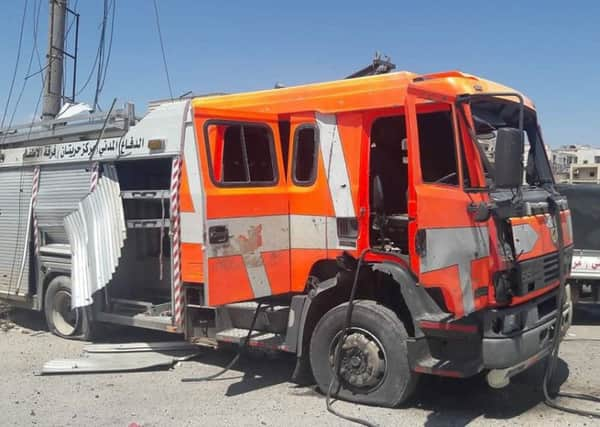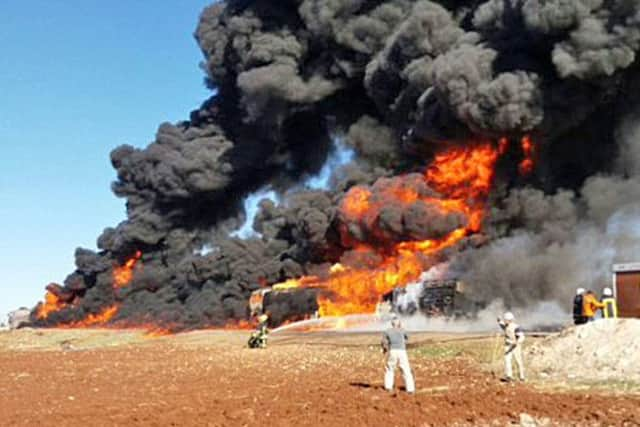From Lancashire's streets to the war zone of Aleppo


Yards away, as thick columns of black smoke rise up from the lengthy stretch of destruction, men in white helmets and fluorescent jackets target the fierce blaze with water.
It reads like a scene from a Hollywood film, and with an innocent family reportedly killed after being caught up in the aerial assault, it’s one that’s presumably hard for the average Gazette reader to relate to.
Advertisement
Hide AdAdvertisement
Hide AdExcept in the picture, posted to Twitter last year by Turkish journalist Levent Kemal, who is covering the atrocities happening daily in both Syria and Iraq, there’s a rather more familiar sight.


It’s a distinctively orange fire engine, believed to have once graced the streets of Lancashire, parked in the dirt in the northern outskirts of Aleppo. Another snapshot, shared to the micro-blogging social media site by The White Helmets, a 2,900-volunteer strong search and rescue service operating in Syria, shows a bomb-damaged orange engine.
Inside were four firefighters injured in Haritan, a besieged town in the north of the war-torn country, close to Aleppo, after they were caught up in an airstrike.
So are these really Lancashire Fire and Rescue Service’s (LFRS) old vehicles, and if they are, just how did they end up in the midst of bloody Middle Eastern battlefields?
Advertisement
Hide AdAdvertisement
Hide AdGiven that both trucks pictured have the service’s distinctive colouring, and are made by DAF trucks, which considers Lancashire its biggest single buyer of fire engines, there is a ‘95 per cent chance’ they are, DAF’s UK marketing manager Phil Moon said. “It’s a reasonable assumption to make,” he said, adding that few others have been sold elsewhere in the UK or abroad in the past decade.


And while LFRS says there are a ‘handful’ of other services around the world that have the same distinctive orange colouring, fire chiefs are quietly convinced local crews once manned the life-saving vehicles on jobs around the county. It is impossible to know for certain where these fire engines came from without knowing the registration details,” a service spokesman said.
“However, if the fire engines in either of these pictures were previously used by LFRS, then they would have been sold at auction or by a lease company.”
The service currently has more than 60 fire engines that are either operational or used for training.
Advertisement
Hide AdAdvertisement
Hide AdWhen they reach the end of the shelf-life, it has an obligation to get the best value for money for taxpayers by selling them. Private customers have included baked beans giant Heinz, former nuclear fuel manufacturer BNFL, and charity Operation Florian, which is run by volunteers and ships reconditioned vehicles and other specialist equipment around the world.
Historically, old Lancashire engines have ended up in Croatia and Zimbabwe, while firefighters from across the north west have travelled abroad with the charity to train local crews on how to use them.
“We are not aware of Operation Florian taking Lancashire fire engines to Syria,” the service said, while Bernie Lees from the charity insisted: “We have not been involved in Syria. If they are Lancashire engines, they probably came from auction. You get dealers who trade in second-hand fire engines, they might have bought them and sold them on.”
This theory is given weight by the engines’ lack of blue lights in the photographs.
Advertisement
Hide AdAdvertisement
Hide AdWhen engines are sold by LFRS, its branding and logo is removed in all cases. But when they are sold at auction, the last being in July 2014, their blue lights and sirens are also removed.
So if they are Lancashire trucks, they were likely moved into Syria and the area of Aleppo, its largest city, by a private party. That may have happened before the fighting, which still rages today four years after first breaking out, and before ISIS gained a foothold in the region.
As for the people using them, The White Helmets recently earned a Nobel Peace Prize nomination, and were pipped only by Colombian President Juan Manuel Santos, for his efforts to negotiate peace with the Farc guerillas.
The ordinary civilians-cum-heroes routinely spend hours digging through rubble looking for innocent survivors of the brutal civil conflict and, as the Nobel announcement was made, tweeted simply: “Back to work.”
Advertisement
Hide AdAdvertisement
Hide AdOrlando von Einsiedel, who shot a documentary about The White Helmets, said: “Their work cuts through politics. They’re people like you and me – teachers, shopworkers – who found themselves in an extraordinary situation and decided not to pick up a gun and not to flee Syria but to go out and save strangers.
“The focus is on stopping the bombs, it doesn’t matter who they are from, it just matters that they are falling every day in civilian areas.”
These engines were built locally to save local lives, but when they are no longer high-tech enough or reliable enough to do it here, it’s surely better for them to be used in such remarkable circumstances than to rot in a mechanical graveyard just off the M55.